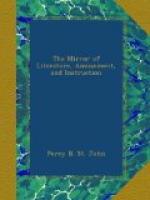I turned from these sights to the natural beauties of the park, which, aided by the happy inequalities of the ground, (which French artists imagined would be such an obstacle to its perfection,) possesses far more variety than is usually found in the pleasure-grounds of France. The original plantation of the park was the work of La Notre, who, it will be recollected, planned the garden of Versailles; but St. Cloud is considered his chef-d’oeuvre, and proves, that with the few natural advantages which it afforded him, he was enabled to effect more here than millions have accomplished at Versailles—where art is fairly overmatched with her own wasteful and ridiculous excess. This alone ought to make the French blush for that monument of royal folly.
The situation of the chateau is its greatest attraction. It possesses a fine view of Paris, which is indeed a splendid item in the prospect of the princely occupants; and the sight of the capital may, perhaps, be a pleasant relief to the natural seclusion of the palace.
One of the most remarkable objects in the park is a kind of square tower, surmounted with an exact copy, in terra cotta, of the lantern of Diogenes at Athens, ornamented with six Corinthian columns. It is used as an observatory, and, like its original, is associated with the name of the illustrious Grecian—it being also called the lantern of Diogenes. Its view of the subjacent plain overlooks the city of Paris by a distance of twenty miles.




